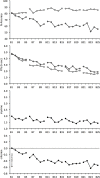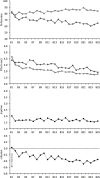Face matching in a long task: enforced rest and desk-switching cannot maintain identification accuracy
- PMID: 26312179
- PMCID: PMC4548491
- DOI: 10.7717/peerj.1184
Face matching in a long task: enforced rest and desk-switching cannot maintain identification accuracy
Abstract
In face matching, observers have to decide whether two photographs depict the same person or different people. This task is not only remarkably difficult but accuracy declines further during prolonged testing. The current study investigated whether this decline in long tasks can be eliminated with regular rest-breaks (Experiment 1) or room-switching (Experiment 2). Both experiments replicated the accuracy decline for long face-matching tasks and showed that this could not be eliminated with rest or room-switching. These findings suggest that person identification in applied settings, such as passport control, might be particularly error-prone due to the long and repetitive nature of the task. The experiments also show that it is difficult to counteract these problems.
Keywords: Face matching; Face perception; Passport control; Unfamiliar faces.
Conflict of interest statement
The authors declare there are no competing interests.
Figures



References
-
- Alenezi HM, Bindemann M. The effect of feedback on face-matching accuracy. Applied Cognitive Psychology. 2013;27:735–753. doi: 10.1002/acp.2968. - DOI
LinkOut - more resources
Full Text Sources
Other Literature Sources
Molecular Biology Databases

